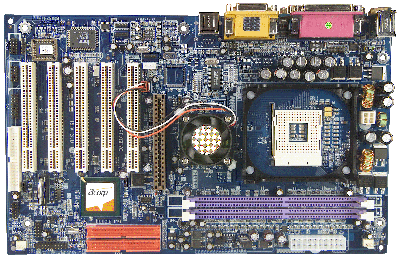

|
|


DOWNLOADS DRIVERS MANUALS BIOS Motherboards Mainboards HDD Harddisk IDE Cards Removable drives CD-ROM CDRW DVD-ROM DVD-RW DVD+RW Firmware Update Upgrade VGA Graphic Card Video Sound Sound Card Audio Soundcard Modem Modems ISDN Notebook Notebooks Laptop Laptops Monitor TFT LCD SCSI Adapter Printer Printers Plotter Multioffice USB Scanner Tape Backup Input Device Mouse Joyistick Digital Camera Camcoders Network Card LAN Wireless Wifi Adapter Adapters Card Cards Tests Diagnostics RAM Memory HDD Antispyware Remove Spyware adware...etc CPU Support Compatibility RAM Memory Support Compatibility VIRUS REMOVAL TOOLS |
4845PE - ACORP 
Socket 478, Intel P4 (HT), Intel 845PE + ICH4, FSB 400/533 MHz, ATX, DDR333, 6 Ch AC'97 Sound, AGP 4X, Ultra DMA 66/100, WOA, WOM, WOL, Over Clock/Voltage, USB2.0, SPII support, VGA Protection -------------------------------------------------------------------------------- Chipset The new Intel® Pentium® 4 processor at 3 GHz with an advanced 800 MHz system bus offers higher levels of performance, creativity and productivity. Based on Intel® NetBurst? microarchitecture and built with Intel's 0.13-micron technology, the Pentium 4 pro The Pentium 4 processor at 3 GHz with an advanced 800 MHz system bus also supports Hyper-Threading Technology, enabling you to multitask more efficiently when you run demanding applications at the same time. Hyper threading technology A chipset is the heart of the motherboard, pumping data between the processor, memory and I/O peripherals. Simply put, chipsets that support Hyper Threading Technology give PCs a turbo-charge, delivering the power users and PCs need to multi-task and incr Intel chipset designs have been optimized to support Hyper-Threading Technology, which brings additional intelligence to systems so that multiple tasks received from the processor can be managed and prioritized more effectively. The combination of an Inte unmatched system performance and responsiveness. PCs based on the Intel® Pentium® 4 Processor with HT Technology run much faster and more efficiently. This gives today's multi-tasking user the ability to listen to music, watch movies, play games, capture streaming video off the Internet, and more - with FSB 400/533 MHz Frontside bus: the bus within a microprocessor that connects the CPU with main memory. The so-called dual independent bus (DIB) architecture allows a processor to use both this and the backside bus (which connects the CPU and the Level 2 cache) simultaneo DDR 200/266/333 MHz Double Data Rate: a memory technology that works by allowing the activation of output operations on the chip to occur on both the rising and falling edge of a clock cycle, thereby providing an effective doubling of the clock frequency without increasing t 6 Channel AC'97 Sound High-Quality Audio Versatile I/O Capability Cost Saving Power Management Driver/Software Support UDMA 66/100 Ultra ATA/100 - expected to be the final generation of Parallel ATA interface before the industry completes its transition to Serial ATA - was announced in 2000. Also referred to as Ultra DMA mode 5, the new specification uses the same 40-pin, 80-conducto Form Factor ATX The predominant motherboard form factor since the mid-1990s. It improves on the previous standard, the Baby AT form factor, by rotating the orientation of the board 90 degrees. This allows for a more efficient design, with disk drive cable connectors near PCI x 5 In its original implementation PCI ran at 33MHz. This was raised to 66MHz by the later PCI 2.1 specification, effectively doubling the theoretical throughput to 266 MBps - 33 times faster than the ISA bus. It can be configured both as a 32-bit and a 64-bi (IRQ's) to be shared. This is useful because well-featured, high-end systems can quickly run out of IRQs. Also, PCI bus mastering reduces latency and results in improved system speeds. AGP 4X Intel's release of version 2.0 of the AGP specification, combined with the AGP Pro extensions to this specification, mark an attempt to have AGP taken seriously in the 3D graphics workstation market. AGP 2.0 defines a new 4x-transfer mode that allows four l benefit wasn't seen until the implementation of 133MHz SDRAM and Direct Rambus DRAM (DRDRAM) in the second half of 1999. AGP 2.0 was supported by chipsets launched early in 1999 to provide support for Intel's Katmai processor. USB 1.1/2.0 USB 2.0 will extend the capabilities of the interface from 12 Mbit/s, which is available on USB 1.1, to between 360-480 Mbit/s on USB 2.0, providing a connection point for next-generation peripherals which complement higher performance PCs. USB 2.0 is exp the second half 2000. Existing USB peripherals will operate with no change in a USB 2.0 system. Devices, such as mice, keyboards and game pads, will not require the additional performance that USB 2.0 offers and will operate as USB 1.1 devices. All USB devices are expected to< the architectural limits of USB. Given USB's already wide installed base, USB 2.0's backward compatibility could prove a key benefit in the battle with IEEE 1394 to be the consumer interface of the future. CPU Support Compatibility RAM Memory Support Compatibility Manufacturer - downloads drivers, manuals and BIOS : ACORP Prodejce v ČR : Možnost vložení odkazu prodejce - info zde Recenze : Odkazy na recenze vložíme po dohodě Problems, experience, griffs.....: |
|